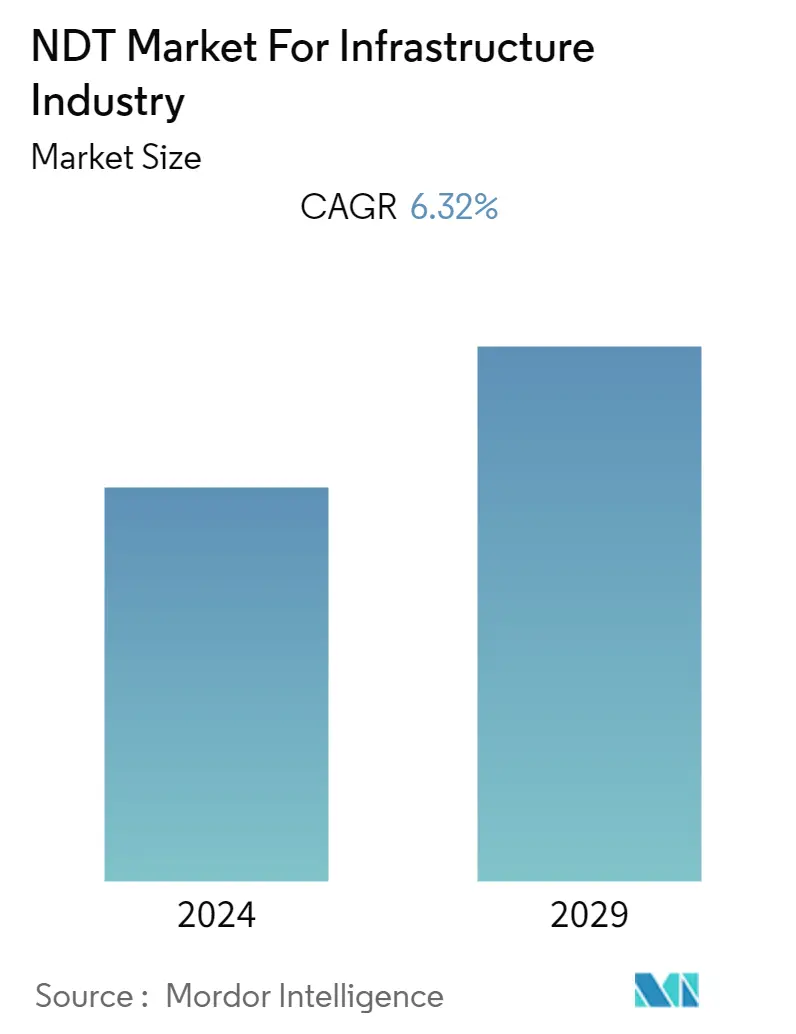Market Size of NDT Industry For Infrastructure Industry

| Study Period | 2019 - 2029 |
| Base Year For Estimation | 2023 |
| CAGR | 6.32 % |
| Fastest Growing Market | Asia Pacific |
| Largest Market | North America |
| Market Concentration | Low |
Major Players.webp)
*Disclaimer: Major Players sorted in no particular order |
Need a report that reflects how COVID-19 has impacted this market and its growth?
NDT Market Analysis
The Non-Destructive Testing Market for the Infrastructure Industry was valued at USD 40.53 billion in the previous year and is expected to register a CAGR of 6.32%, reaching USD 58.83 billion by the next five years. One of the main factors propelling the market is an increase in investment in the modernization of infrastructures in various sectors and the building of new structures and other commercial infrastructures. Additionally, opportunities in the market under study are being created by investments in infrastructure modernization.
- Non-destructive testing (NDT) is the inspection, testing, or evaluation of components, materials, or assemblies. It entails examining differences in characteristics or discontinuities without impairing the product's usability or a component. The market for non-destructive testing in the infrastructure sector is expanding quickly as a result of rising infrastructure development, an increase in the number of aging buildings and bridges, and growing government attention to public safety.
- Natural disasters put real estate and infrastructure assets to the ultimate test, threatening their integrity and posing severe consequences. Technical non-invasive and semi-invasive tests are gaining popularity because they help industry stakeholders learn crucial information about the properties of the materials the structures are made of or are anticipated to be used in new construction. This is because the infrastructure sector involves a significant investment, and human safety is on the line.
- In addition, expanding construction projects have a significant role in the infrastructure sector's non-destructive testing market. This is due to on-site or laboratory testing during the construction stage of materials and building components. The development of this market is anticipated to be aided by technological developments that make cutting-edge variants readily available.
- Over the forecast period, it is expected that the shortage of qualified NDT professionals will persist because there is yet to be an obvious solution. Therefore, the need for more trained personnel and training facilities in the NDT market is expected to impact the market's expansion over the forecast period. In addition to this, the depth of inspection for most components has been usually limited to a maximum depth of 100-150mm, which means that the inspection depth is much less than the wavelength of light.
- Furthermore, the COVID-19 pandemic had a significant impact on the non-destructive testing (NDT) industry owing to limited access to infrastructure sites, making it difficult for NDT inspectors to conduct on-site inspections. This led to delays and reduced efficiency in the inspection process. With travel restrictions in place, there was an increased demand for remote NDT inspection techniques such as remote visual inspection (RVI) and unmanned aerial vehicles (UAVs) for infrastructure inspection. While these techniques can be effective, they may not be suitable for all types of infrastructure and can be limited by factors such as weather conditions.
